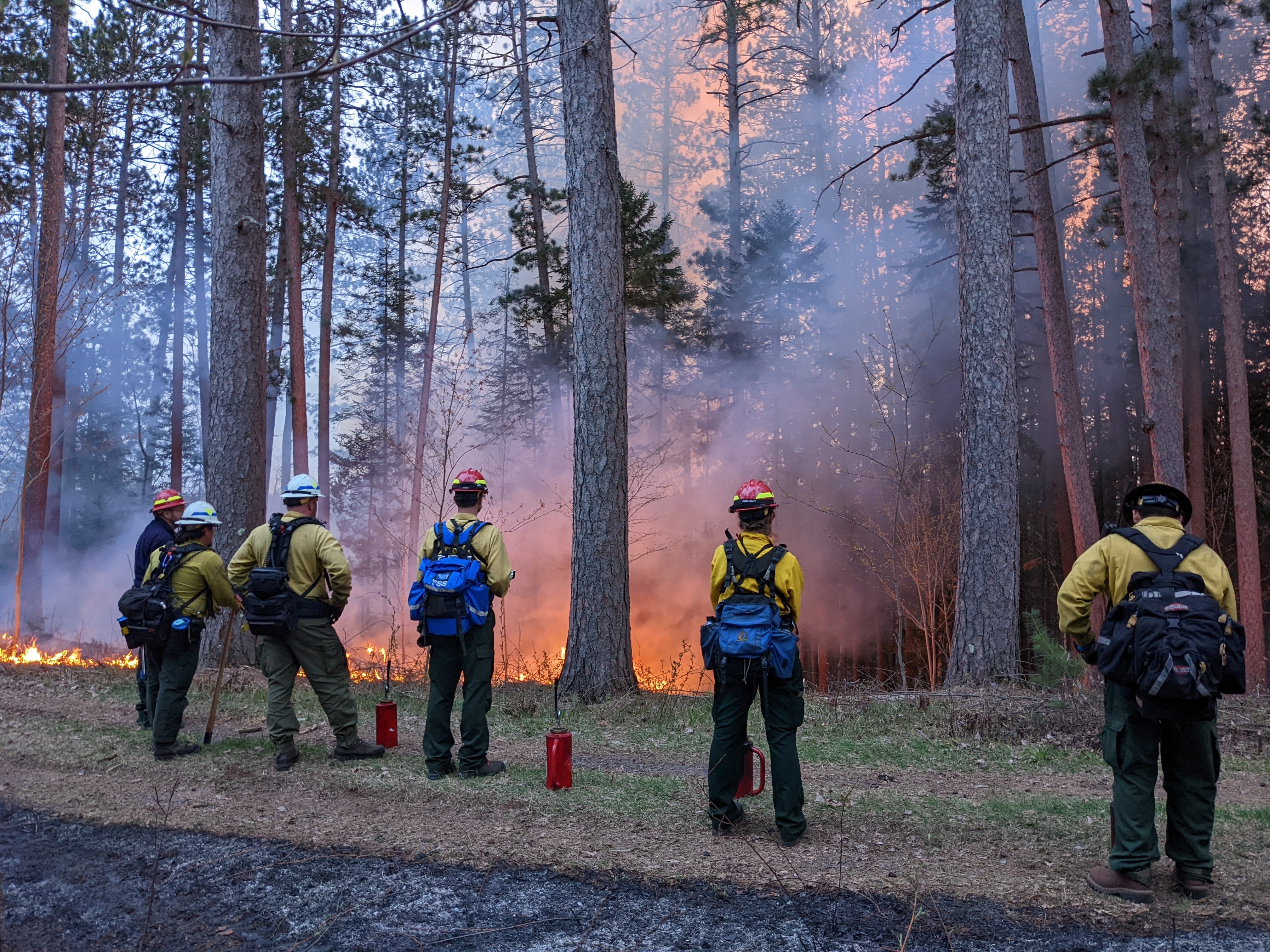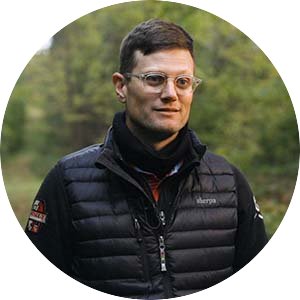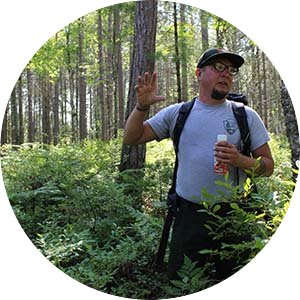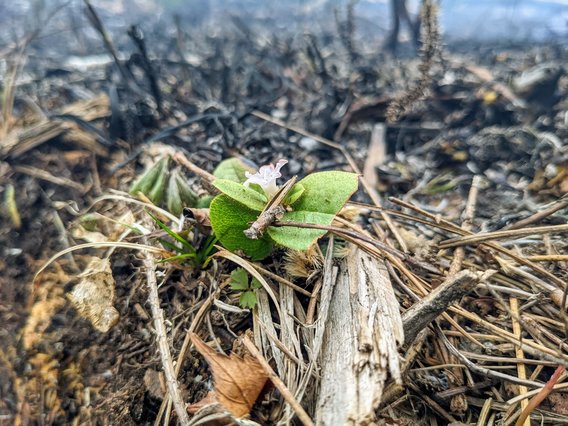
Ojibwe firefighters restore fire to the Cloquet Forestry Center
Collaboration between the Fond du Lac Band of Lake Superior Chippewa, Bureau of Indian Affairs and U of M opens new chapter, embraces the role of Indigenous fire in shaping the Center’s forests
CLARE BOERIGTER, COLLEGE OF LIBERAL ARTS, MFA '21
This spring, Vern Northrup stood beneath the red and white pines at the University of Minnesota’s Cloquet Forestry Center (CFC) and lit the first prescribed fire the forest had seen in 20 years. With more than two decades of experience as a firefighter for the Bureau of Indian Affairs, Northrup had lit prescribed burns like this hundreds of times before. Today, however, was different. Northrup, an elder of the Fond du Lac Band of Lake Superior Chippewa, was restoring fire to the CFC, a 3,400-acre forest within the Fond du Lac Reservation which his ancestors would have once regularly stewarded with fire, a practice rooted in both Ojibwe culture and landscape management.
On May 11 and 17, 2022, firefighters from the Fond du Lac Band, Bureau of Indian Affairs, Bois Forte Band of Chippewa, Grand Portage Band of Lake Superior Chippewa, Mille Lacs Band of Ojibwe, Leech Lake Band of Ojibwe and The Nature Conservancy gathered with U of M staff to burn 75 acres at the CFC. Before U of M management of this forest began in 1909, Ojibwe land stewards regularly burned here, with tree records suggesting that fires had once swept through the forest at a minimum of every 13 years on average, and with Fond du Lac community memory suggesting burns were even more frequent. Over time, this forest and many of the species present here thrived because of fire rather than in spite of it. Yet until recently, only 20 acres had been managed using prescribed fires, with two smaller burns lit in 1992 and 2002. For many, the burns this spring were long-awaited: they signified both the return of fire to a fire-adapted ecosystem and the restoration of the deeply-rooted Ojibwe cultural practice of burning.
“Bringing fire back to this landscape isn’t just about the ecological benefits,” said Damon Panek, wildfire operations specialist for the Fond du Lac Band. “For us, burning is about fulfilling our role in the relationship we have with the land. We’re doing this for our culture, our identity and our way of life.”
For Indigenous communities around the world, igniting burns is a key practice in maintaining healthy relationships with the landscapes they call home. These fires serve important cultural and ceremonial purposes, as well as bringing benefits to ecosystems and humans alike, from opening thick forests for hunting, travel, and settlement to promoting the growth of specific fire-adapted plants which are gathered as food, medicine or materials. In Minnesota, cultural burning prompted an abundance of blueberries, historically a staple food source for the Fond du Lac Band and other Ojibwe, and cleared understories of dense brush, giving a competitive edge to fire-adapted red pines while creating a welcoming environment for villages and camps.
In 2016, CFC staff and research partners from the University of Wisconsin-Platteville began detailing the forest’s long history of fire — and investigating possible ways to bring these burns back. The high frequency of surface fires evident in the forest’s fire history clearly indicated that humans — rather than lightning strikes — were likely the ignitors for many of these burns. And now, without fires and their ignitors, some of the CFC’s most prominent fire-adapted ecosystems were beginning to change into new types of forest. Here, CFC staff turned to Ojibwe fire experts like Northrup and Panek, and traditional knowledge holders like Tom Howes, Fond du Lac Resources program manager, and Jeff Savage, Fond du Lac Band Cultural Center and Museum director.

“The research has drawn a really clear link to the fact that these fires [on the Center forest] were not in the absence of humans,” said Kyle Gill, the CFC’s forest manager. “They were actually because of humans. And once we started to ask our Indigenous partners questions, they let us know, ‘Yeah, we were kind of working with fire everywhere. You all just didn't ask us."
In early 2022, the collaboration between U of M staff at the CFC, the Fond du Lac Band of Lake Superior Chippewa, and the Bureau of Indian Affairs was formalized in a memorandum of understanding (MOU), a legal document which set the stage for collaborative burns at the CFC. The Bureau of Indian Affairs’ Reserved Treaty Right Lands Program provided financial support to move these joint efforts forward, with funds available for fire stewardship at the CFC through 2025.
In May, when favorable weather conditions made it possible to burn safely and effectively, CFC staff and firefighters from the Fond du Lac Band and Bureau of Indian Affairs assembled at the Center forest, calling on additional support from Ojibwe Tribes across Minnesota and The Nature Conservancy. To start the first day of burning, Fond du Lac elder Ricky DeFoe led the firefighters in a cultural ceremony celebrating fire. Then, more than two decades after the last human-lit burn was ignited on the CFC, Ojibwe firefighters led the restoration of fire to a forest their ancestors would have once regularly burned.

Using drip torches — fuel canisters with curlicue spouts — the firefighters strategically lit fires beneath red and white pines, following the directions of ignitions boss Carl Crawford from the Bureau of Indian Affairs. They were burning in areas identified in the prescribed burn plan, created for the CFC by partners at the Forest Stewards Guild and reviewed by collaborators at The Nature Conservancy. These selected locations had been prepped for fire with containment lines and fuel-reduction techniques. While a handful of firefighters ignited, others monitored the flames under the direction of holding boss BJ Gotchie, forestry and fire restoration coordinator for the Leech Lake Band of Ojibwe. Over two days of burning, the firefighters brought fire back to 75 acres of the forest. The group also strengthened ties as partners united around a common goal: the restoration of fire as a cultural and ecological practice.
Reflecting on the experience of burning, Panek said: “I always think about how our ancestors would see us doing this: the sounds, the smells, the visuals. I could feel the heat on my face as I watched the flames backing down the hillside around those red pines. And I thought, ‘I’m seeing a scene they would have seen,’ and I felt so connected to my ancestors.”
For Gill, these collaborative burns were also a landmark moment — and a cause for deep appreciation. “I was overwhelmed by the amount of gratitude I had for our partners in the restoration effort,” he said.

Fire shaped the Cloquet Forestry Center — and the rest of Minnesota
For centuries, fire was a key force shaping landscapes across America and the world, including in Minnesota. Fires sparked by lightning burned through forests and across prairies, giving fire-resilient plants a leg up while deterring other species from growing. Humans also played an important role: Indigenous communities often used cultural fire to manage the environments they inhabited — and many continue to do so today. Burns can be used to drive game, create travelways, encourage specific plants to grow, serve ceremonial purposes and more, with this practice playing an important ecological and cultural role. Here in Minnesota, the Ojibwe identity, language, and way of thinking are tied to landscapes which they shaped with fire.
While Indigenous communities have long spoken of their use of fire as a cultural practice and management tool, it’s only recently that Western scientists and land managers have taken note. As current studies continue to affirm, human-lit fire was once a powerful player in the Great Lakes Region. Burns helped promote the growth of fire-adapted species like blueberries and red pine. In fact, many of the old-growth forests prized by Minnesotans today developed because fire was present on the landscape, not absent. The pine forests of Itasca State Park and the Boundary Waters Canoe Area Wilderness both display rich fire histories, visible to curious visitors in the black fire scars burned into the trunks of many of these old-growth trees.
Beginning in the 1900s, however, the criminalization of Indigenous burning practices and the implementation of fire suppression policies by federal and state land management agencies largely removed fire from the landscape. These policies were not only a complete reversal of the management practices which had come before — they also intentionally denied Indigenous peoples the use of fire, making a culturally important act which had been carried out across generations punishable by fines and prison time.

At the CFC, Gill is hoping to begin a new chapter — one that embraces collaboration with Ojibwe partners and acknowledges the role of fire in shaping the Center’s forests. As affirmed by research in 2017 conducted by Evan Larson, a professor at the University of Wisconsin-Platteville who specializes in the study of tree rings, many of the CFC’s oldest pine stands experienced low-intensity fires at least every 13 years on average, a history visible through fire scars in their rings. Even this fire-scar record is a conservative one, as burns need to reach an intensity level high enough to scar a tree in order to be counted, with tree-ring-based fire histories like this often under-recording the number of fires within a study area. It was these frequent burns, many lit by Ojibwe land stewards, which helped red pines and other fire-adapted species to flourish.
With the removal of these fires, ecological changes have come to the CFC, particularly to the pine stands which were set aside to be left unmanaged as an example of the “wild” forests that existed before Euro-American colonization. Of course, the very premise behind these reserve stands is wrong: these forests were actively managed by Ojibwe communities, and they were often managed with fire.
Now in the absence of human-lit burns, these reserve stands are slowly beginning to transform: without regular burns to thin the forest, young red pines have difficulty establishing beneath a thick overstory, as do species like wintergreen, honeysuckle, sweet fern, bearberry and trailing arbutus. While Western forest management practices like mechanical thinning can be implemented to maintain species like these in the short-run, fire-dependent ecosystems without fire will become exceedingly rare. Absent human-ignited burns, an entirely new type of forest ecosystem will emerge, shifting these stands to something quite different than what exists today and what Ojibwe land stewards would have known before the arrival of Euro-American colonizers.
In order to support the CFC’s fire-adapted ecosystems — including plants, fungi, insects and yes, us as humans who value all of these things — the best bet is to reintroduce burns, guided by local Indigenous wisdom and complemented by Western forestry techniques. CFC staff, Tribal partners and many other forest stewards are aware of this reality, both here and across Minnesota. With a burn program led by Panek, the Fond du Lac Band is quickly becoming a leader in efforts to restore fire. “We want to have one of the nation’s strongest groups of Tribal fire practitioners,” Panek said. “We want to be a voice for changing this [anti-burning] paradigm, for showing how we can safely use fire to maintain a healthy relationship between land and people.”
What comes next?

After twenty years, restoring fire to the CFC in partnership with the Fond du Lac Band, Bureau of Indian Affairs and other local Tribes is a cause for celebration. But it’s also just the beginning. For the fire-adapted forest at the CFC to feel the ecological impacts of fire, these burns need to recur regularly. Similarly, the partnership between the CFC and the Fond du Lac Band needs continued commitments to meaningful collaboration and long-term partnership by the U of M. For Panek, this means more burning in the future, led by Fond du Lac firefighters. “Burning is the perfect land acknowledgment,” he said “We’re not just talking about the fact that we burned here: we’re actually doing it.”
Northrup is also heartened by the recent partnership. “[The Cloquet Forestry Center] has been a 3,000-acre hole in our heart,” he said. “But now with this collaboration, we’re feeling a lot more that we can say ‘Okay, we’re part of this again. We’re part of this land again.’”
Land Recognition
The Cloquet Forestry Center (CFC) is located on the reserved lands of the Fond du Lac Band of Lake Superior Chippewa on the unceded territory of the Great Lakes Anishinaabeg. The CFC was established in 1909 after the St. Louis River Mercantile Company donated roughly 2,000 acres of land to the University, alongside the purchase by the University of an additional 500 acres. Additional purchases and donations contribute to the present 3,400 acres of the CFC, land stewarded by the University on the Fond du Lac Reservation. This unceded land was identified as being the sovereign and commonly held lands of the Fond du Lac Band in the 1854 Treaty of LaPointe before the enactment of the Nelson Act of 1889. This act, along with the Dawes Act of 1887, legalized land abuses against Indigenous peoples in Minnesota and the U.S., resulting in the eventual loss of 100 million acres of reservation land across America. Learn more about the Fond du Lac Band and their history
This article was written by environmental storyteller and former wildland firefighter Clare Boerigter. For more of her work, visit clareboerigter.com.













